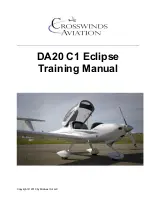
_
57
_
EN
_
56
Optional extra: Speedbrake Riser
The ION 4 can be fitted with an optional Speedbrake Riser. This is a tie
strap which allows the pilot to “decelerate” the wing. If the pilot pulls
the C-riser back and downwards in a radius (with the maillon as the
centre of rotation), the B-riser is also reduced in length. The result is
that the wing flies slower and without creases. More specific informa-
tion can be found here: www.nova.eu/speedbrake
Important:
If the Speedbrake is pulled too much or too suddenly when
the wing is already pitched back there is the risk of stall. Please prac-
tise using the Speedbrake Riser slowly, incrementally and in calm con-
ditions.
Speed system geometrical data
If the entire range of the speed system is utilised, the A-risers are
shortened by approximately 17.5 centimetres in comparison to the
C-risers (sizes M and L).
Turning
Turning a wing is the combination of inner brake, outer brake and
weight-shift. The key is the correct dose of each element. One of the
features of the MENTOR 4 is its sensitive handling. Small brake inputs
are sufficient to fly precise turns.
In thermals, in addition to the inner brake, we recommend lightly bra-
king on the outside as well – this helps to control bank and speed of
rotation, i.e. you get better feedback from the wing. Additionally this
increases the stability of the wing tip. Tight, controlled turns and
smooth direction changes need practise but should be a skill all pilots
have mastered.
Please note: if the paraglider is no longer steerable using the brake
lines (for example if they have become tangled) then the wing has
limited steering capacity through the C-risers.
This, in combination with weight-shift, still allows reasonable turn
correction. Using this technique also permits a safe landing. The
C-risers should not be pulled so hard that they cause the wing to stall.
The Speedbrake Riser can also be used to steer the glider.
Some of the required techniques can be practised during ground hand-
ling, for example, by attempting to keep the wing flying above your
head without looking at it. This exercise is also useful for successful
forward launches.
Accelerated flight
Fitting the speed system
The majority of harnesses are fitted with two pulleys per side. Some
(lightweight) harnesses instead have two simple rings or loops. The
two speed bar cords are pulled from top to bottom through both pul-
leys/rings and fitted to the foot bar.
The correct length adjustment is important. If it is too short, there is
the danger that the wing is constantly accelerated, which should be
avoided at all costs. If the cords are too short there is the risk that the
speed bar is unreachable.
If the cords are set too long, it is not possible to accelerate the wing to
its maximum speed.
We recommend setting the cords a little too long when first fitting the
speed system, so that the free play can be judged during flight. Then
the slack can be taken up if necessary. Brummel hooks with three ho-
les assist with the simple adjustment of the cord length.
Using the speed system
Before take off or on connecting the risers to the harness, the Brummel
hooks on the speed system must to attached to those on the harness.
Please make it part of your pre-flight routine to connect the speed sys-
tem – it is important for your safety.
The MENTOR 4 is fitted with a very effective and smooth-running
speed system. Up to the maximum speed, the glide performance
remains very high. Pitch correction, i.e. active flying, in accelerated
flight should not be performed through the brakes, but using the speed
system. Therefore if the wing pitches forward, the pilot should not
brake, but reduce the acceleration.
In accelerated flight, steering should be performed either by weight-
shift or through asymmetrical speed bar use (by increasing the accele-
ration on the left side, the wing will turn right).
Please note: using
the brakes during
accelerated flight is
not only detrimental
to performance,
but (in comparison
to non-accelerated
flight) it increased
to likelihood of
collapses!
!
Summary of Contents for MENTOR 4
Page 1: ...Manual _DE _EN...













































